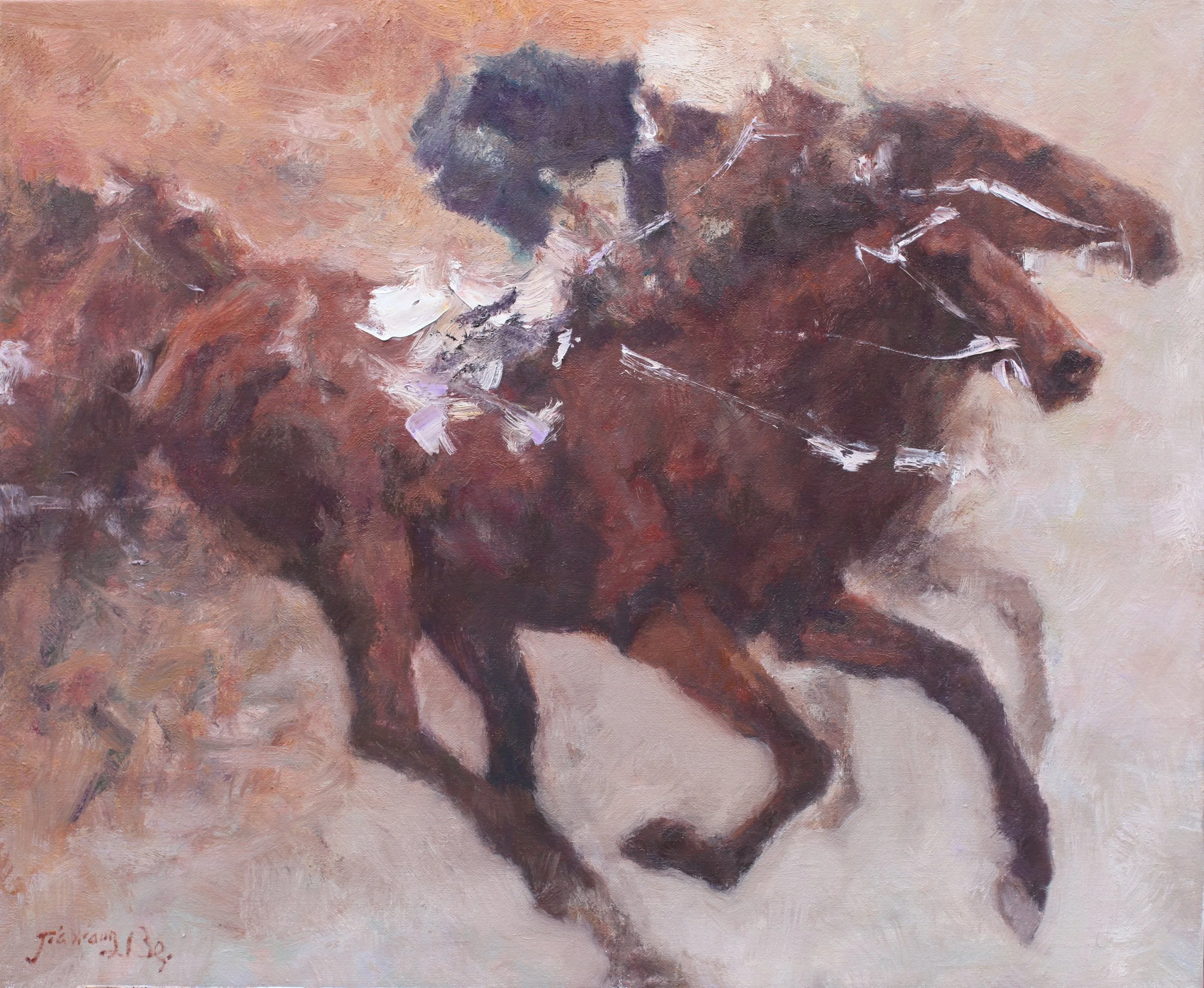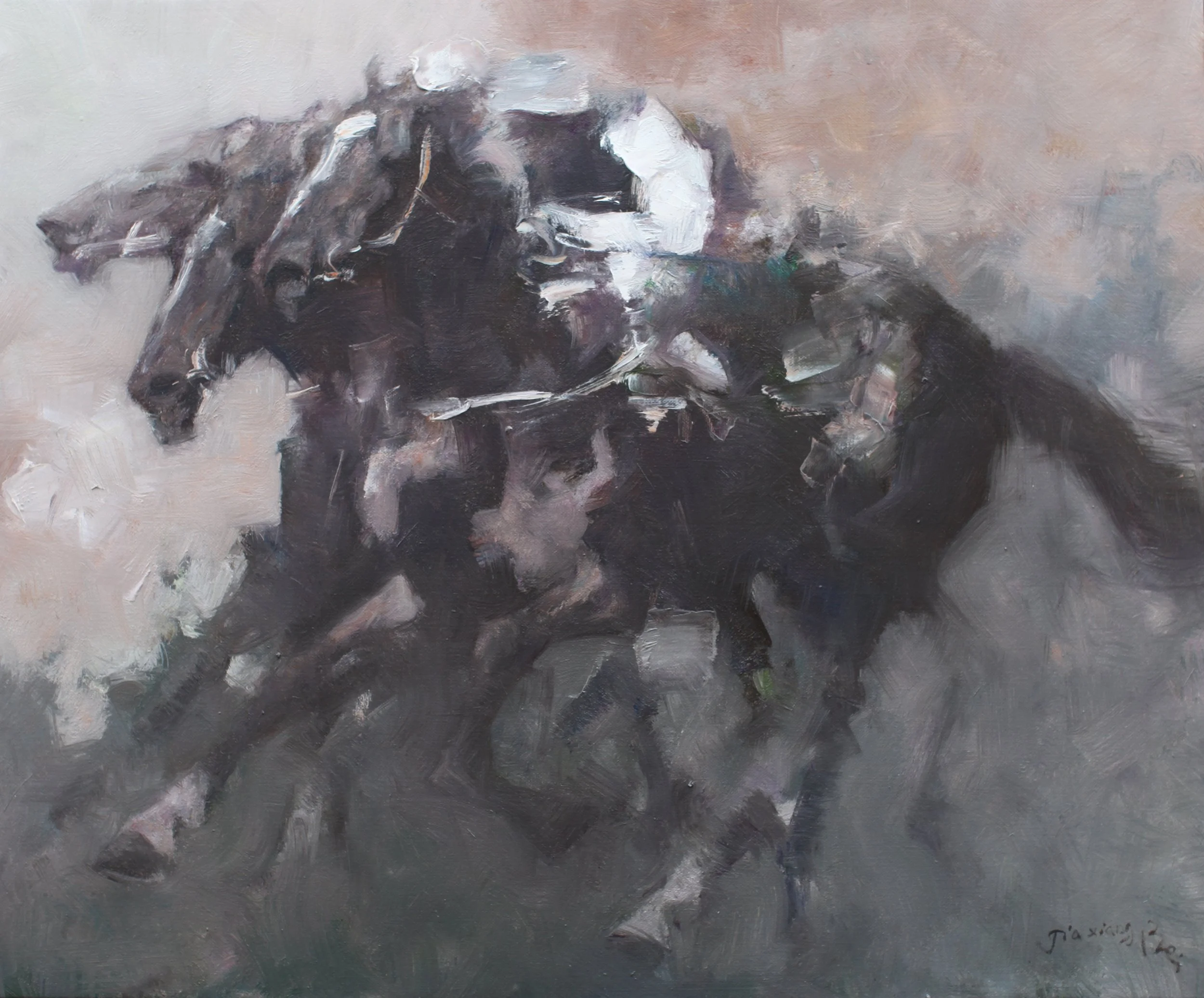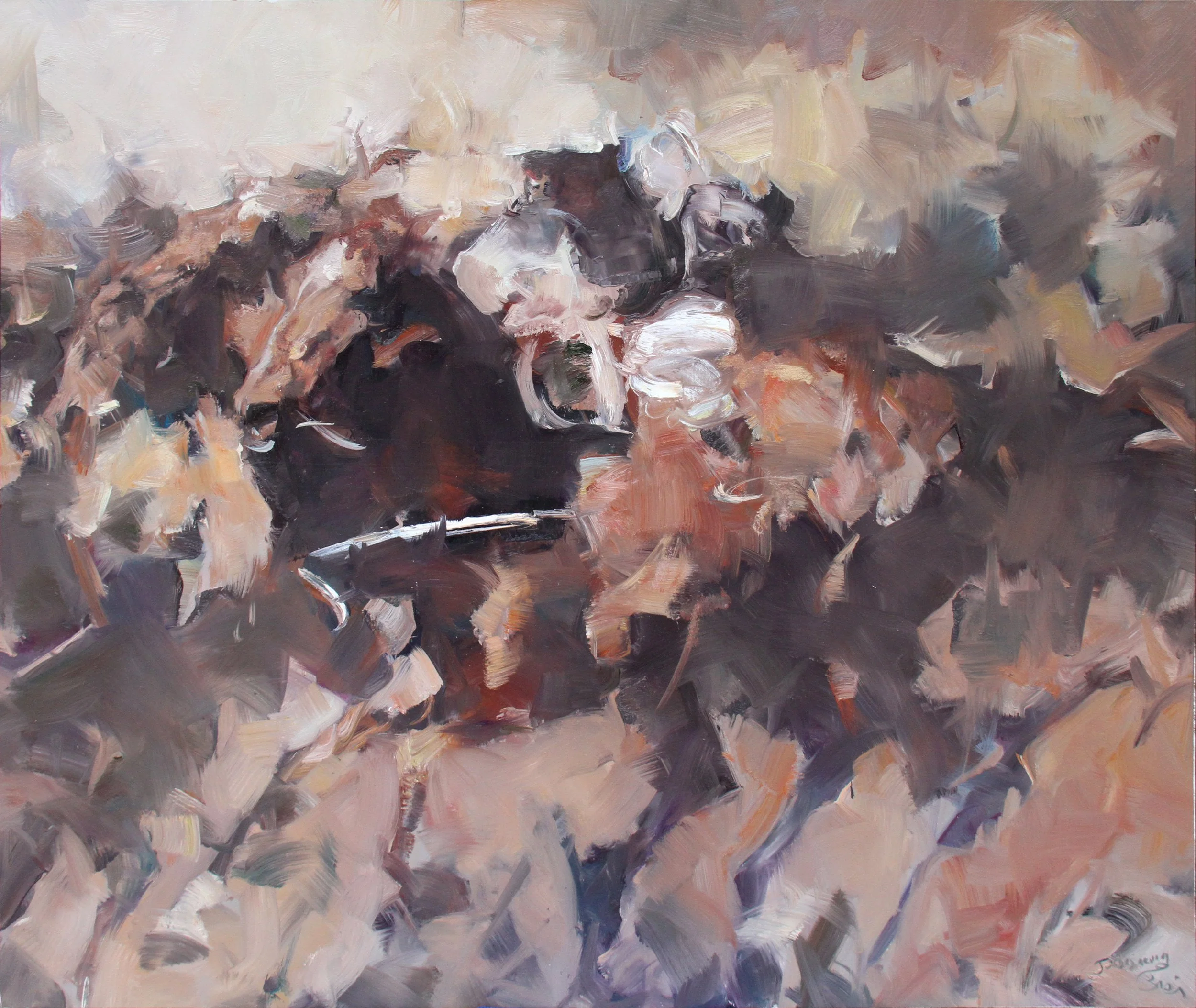
“Among the beasts, only the horse retains its nobility even in the midst of its speed.”
— John Ruskin
In the midst of extreme speed, witness the most composed elegance and vigorous primitive impulse.
Style Evolution
In this series, you will see a big revolution in art style, before and after 2022…
Before 2022…
-

Windrunners
Oil on Canvas
350×205 cm
2017
-

Unity
Oil on Canvas
153×108 cm
2017
-

the Prelude (Collected)
Oil on Canvas
153×108 cm
2017
-

High Noon
Oil on Canvas
153×108 cm
2017
-

The Beaten Path
Oil on Canvas
153×108 cm
2017
-

Waltz (Collected)
Oil on Canvas
91×73 cm
2014
-

Quickening
Oil on Canvas
91×73 cm
2014
-
Comeback
Oil on Canvas
75×62 cm
2015
-

Caballero (Collected)
Oil on Canvas
76×61 cm
2014
-

Surpass (Collected)
Oil on Canvas
73×60 cm
2015
-
Contest (Collected)
Oil on Canvas
73×61 cm
2015
-
Striking
Oil on Canvas
75×61 cm
2015
-

Leap (Collected)
Oil on Canvas
88×70 cm
2015
-

The Unbridled
Oil on Canvas
53×41 cm
2015
-

Lightplay
Oil on Canvas
76×61 cm
2017
-

Treading
Oil on Canvas
60×50 cm
2017
-

The Whip-crack (Collected)
Oil on Canvas
41×53 cm
2015
-

Break Through (Collected)
Oil on Canvas
61×76 cm
2014
-
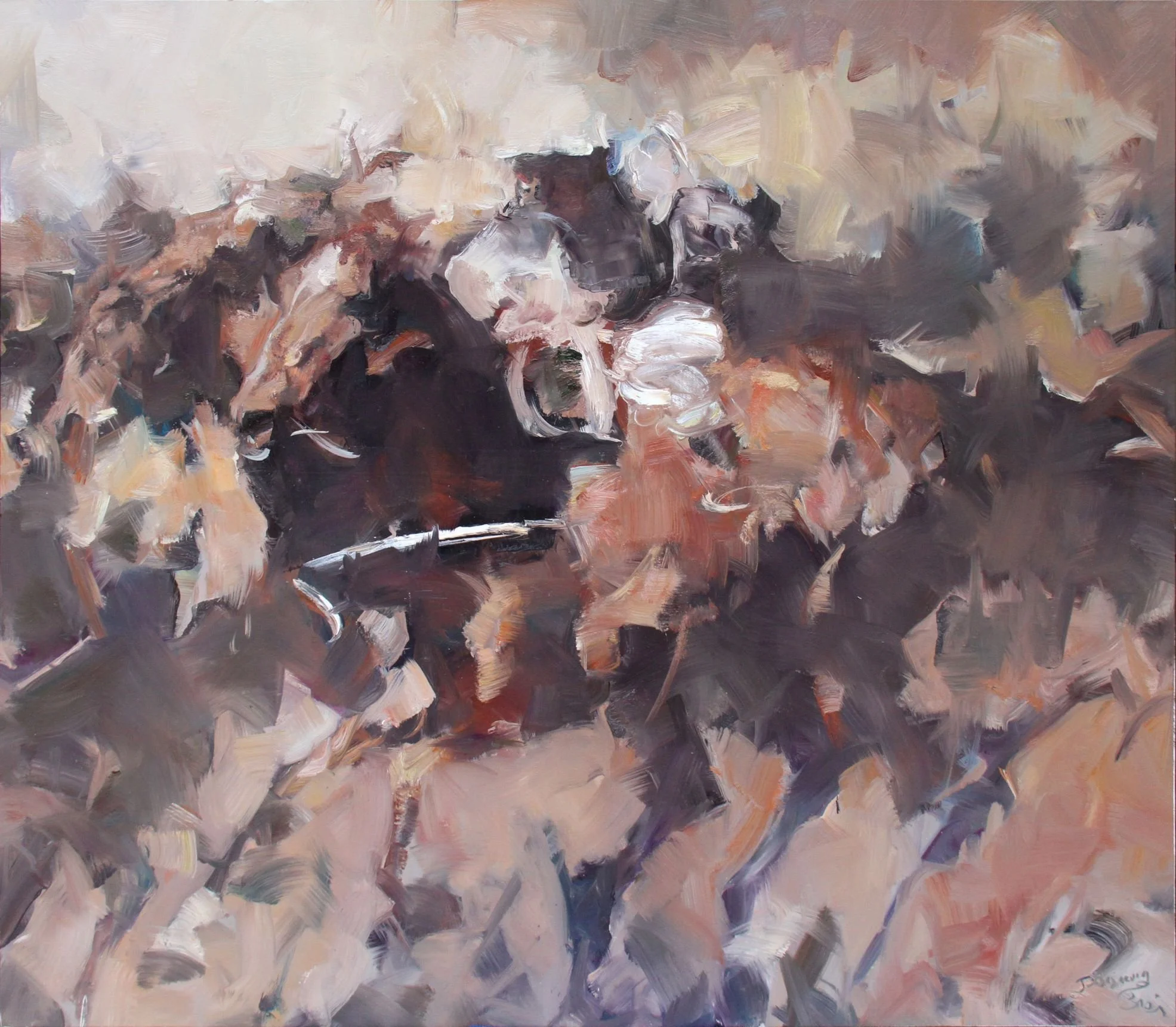
Against Time
Oil on Canvas
158×138 cm
2014
-

the Galloping Steed
Oil on Canvas
158×138 cm
2014
-

the Flash
Oil on Canvas
150×153 cm
2014
-

Unstoppable
Oil on Canvas
150×153 cm
2014
-

Startle the Dust
Oil on Canvas
108×108 cm
2017
-

Afterglow
Oil on Canvas
153×158 cm
2017
-
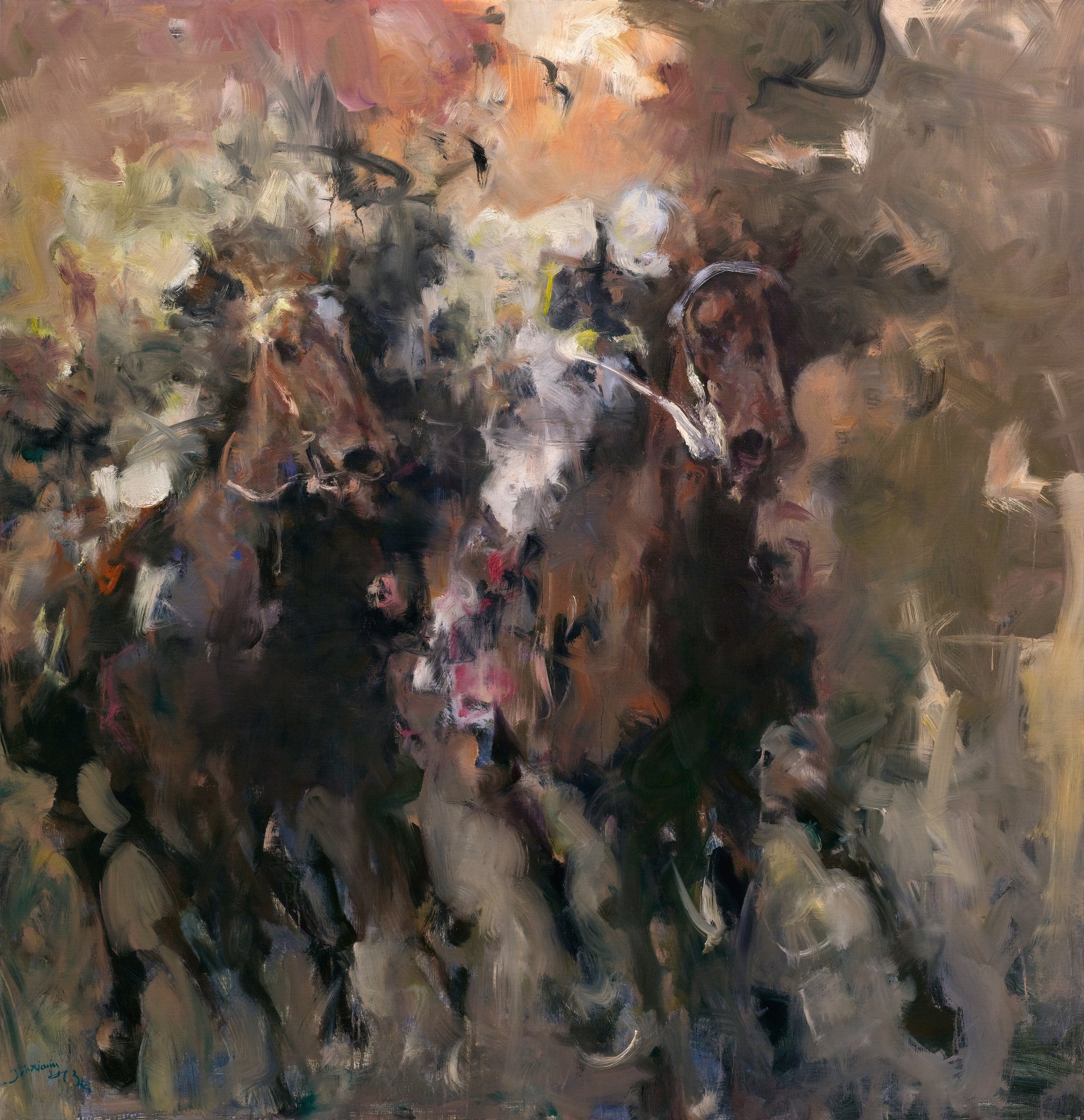
Neigh into Sky
Oil on Canvas
153×158 cm
2017
-

Earthshaker
Oil on Canvas
153×158 cm
2017
-

Fleeting Glory
Oil on Canvas
153×158 cm
2017
-

Wind Blast
Oil on Canvas
153×158 cm
2017
-
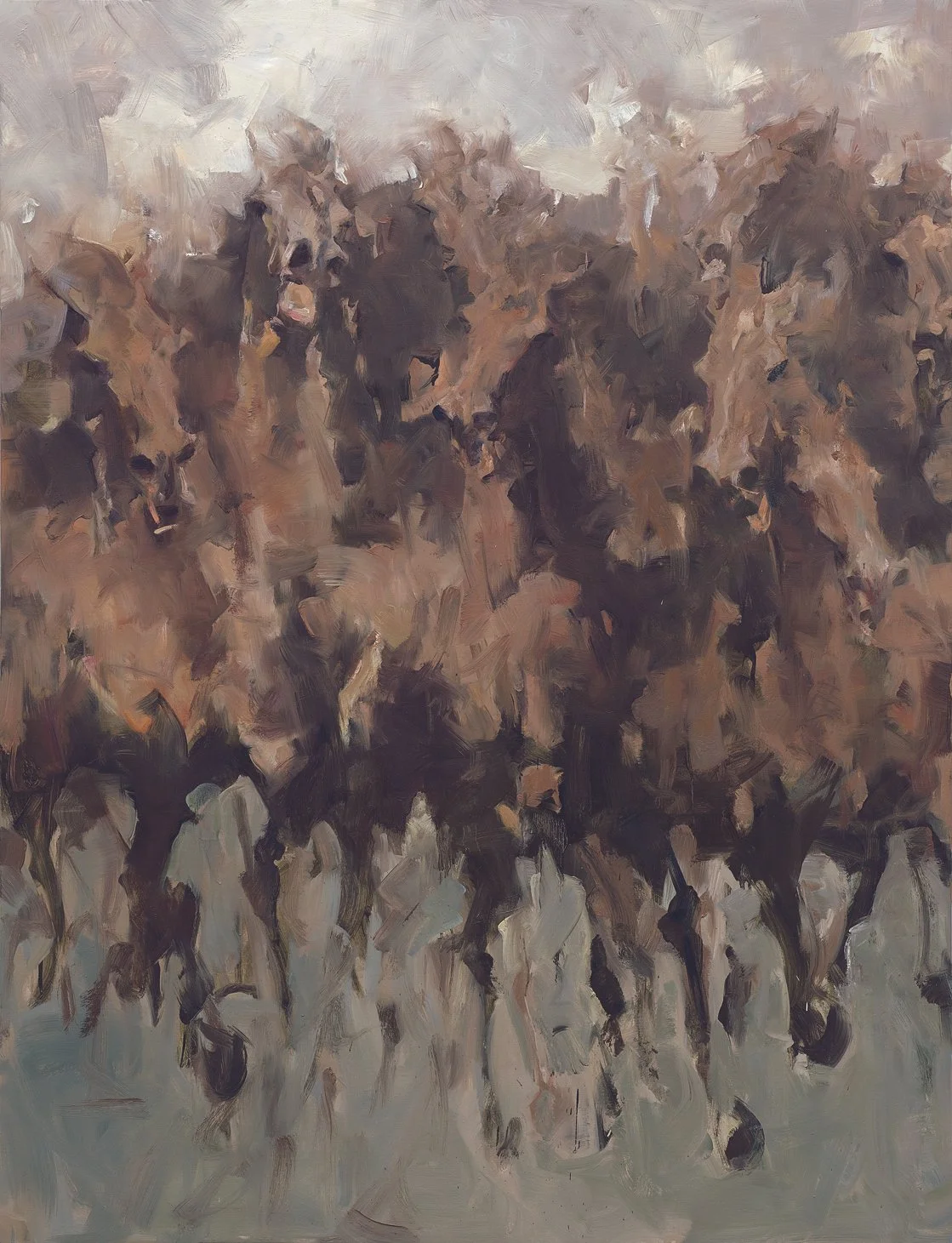
Momentum
Oil on Canvas
150×198 cm
2014
-

-

Horse Whisper 01
Oil on Canvas
91×73 cm
2017
-

Horse Whisper 02
Oil on Canvas
91×73 cm
2017
-

Horse Whisper 03
Oil on Canvas
91×73 cm
2017
-

Horse Whisper 04
Oil on Canvas
91×73 cm
2017
-

Horse Whisper 05
Oil on Canvas
91×73 cm
2017
-

Horse Whisper 06
Oil on Canvas
91×73 cm
2017
-

Horse Whisper 07
Oil on Canvas
91×73 cm
2017
-

Horse Whisper 08
Oil on Canvas
91×73 cm
2017
-

Horse Whisper 09
Oil on Canvas
91×73 cm
2017
-

Horse Whisper 10
Oil on Canvas
91×73 cm
2017
Since 2022…
-

Full Blaze
Oil on Canvas
130×88 cm
2024
-

Night Spirit
Oil on Canvas
130×88 cm
2024
-

Prancing
Oil on Canvas
130×88 cm
2024
-

Streaking to Moon
Oil on Canvas
130×88 cm
2024
-

Striding
Oil on Canvas
130×88 cm
2024
-

Cavalry
Oil on Canvas
130×88 cm
2024
-
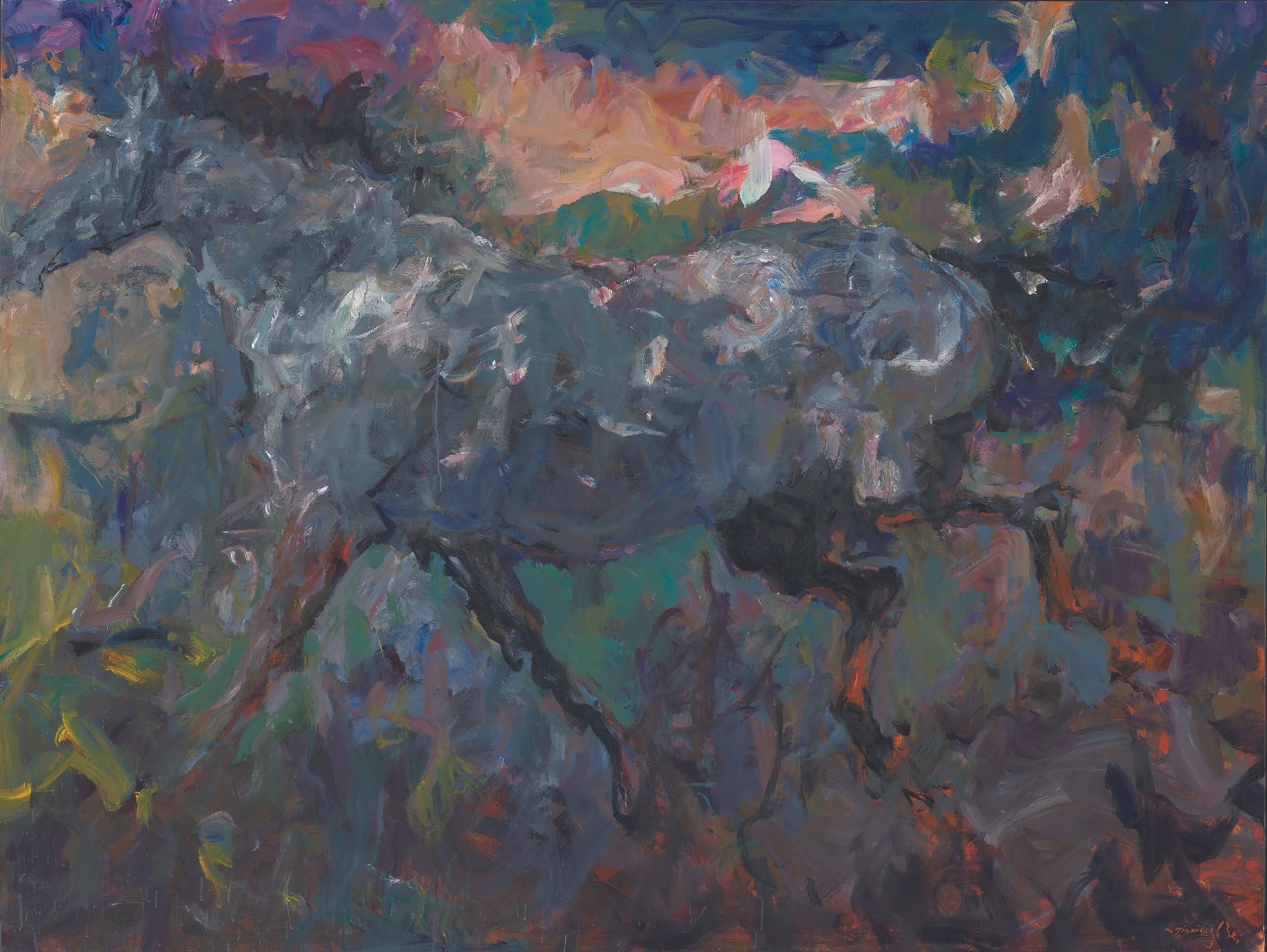
Distant Fragrance
Oil on Canvas
240×180 cm
2024
-

the Legions
Oil on Canvas
240×180 cm
2024
-

Silver in Ash
Oil on Canvas
240×180 cm
2024
-

Fleeting
Oil on Canvas
240×180 cm
2024
-

Whirling in the Wind
Oil on Canvas
240×180 cm
2024
-

the Ethereal Shadow
Oil on Canvas
240×180 cm
2024
-

Journey 01
Oil on Canvas
103×54.3 cm
2023
-

Journey 02
Oil on Canvas
103×54.3 cm
2023
-

Journey 03
Oil on Canvas
103×54.3 cm
2023
-

Splashing Glow
Oil on Canvas
240×180 cm
2024
-

the Herds
Oil on Canvas
240×180 cm
2024
-

Freedom Wing
Oil on Canvas
163×103 cm
2023
-

Dashing in the Breeze
Oil on Canvas
200×180 cm
2024
-

the Phantom Horse 01
Oil on Canvas
80×80 cm
2024
-

the Phantom Horse 02
Oil on Canvas
80×80 cm
2024
-

the Phantom Horse 03
Oil on Canvas
80×80 cm
2024
-

the Phantom Horse 04
Oil on Canvas
72×60 cm
2024
-

the Phantom Horse 05
Oil on Canvas
72×60 cm
2024
-

the Phantom Horse 06
Oil on Canvas
72×60 cm
2024
-

the Phantom Horse 07
Oil on Canvas
72×60 cm
2024
-

the Phantom Horse 08
Oil on Canvas
72×60 cm
2024
-

Racing
Oil on Canvas
153×145 cm
2025
-

Turbulent Dawn
Oil on Canvas
165×120 cm
2025
-

Riding Wind
Oil on Canvas
100×100 cm
2025
-

Divine Steed
Oil on Canvas
100×100 cm
2025
-

Neighing in Wind
Oil on Canvas
100×100 cm
2025
-

Galloping
Oil on Canvas
100×100 cm
2025
-

Graceful Mare
Oil on Canvas
100×100 cm
2025
-

Wind Dancer
Oil on Canvas
100×100 cm
2025
-

the Shadow Steed
Oil on Canvas
100×98 cm
2025
-

Miracle Steed
Oil on Canvas
100×100 cm
2025
-

Thunderclap
Oil on Canvas
100×100 cm
2025
-

Cavalry Surge
Oil on Canvas
100×98 cm
2025
-

Haunting Glimpse
Oil on Canvas
165×120 cm
2025
-

Flaming Sky
Oil on Canvas
165×120 cm
2025
-

Gone in Moonlight
Oil on Canvas
112×162 cm
2024
Drafts of the Inspirations, Like the Horses’ Shadow…
-

Horse Shadow 01
Propylene on Paper
41×29 cm
2023
-

Horse Shadow 02
Propylene on Paper
36×26 cm
2023
-

Horse Shadow 03
Propylene on Paper
28×34 cm
2023
-
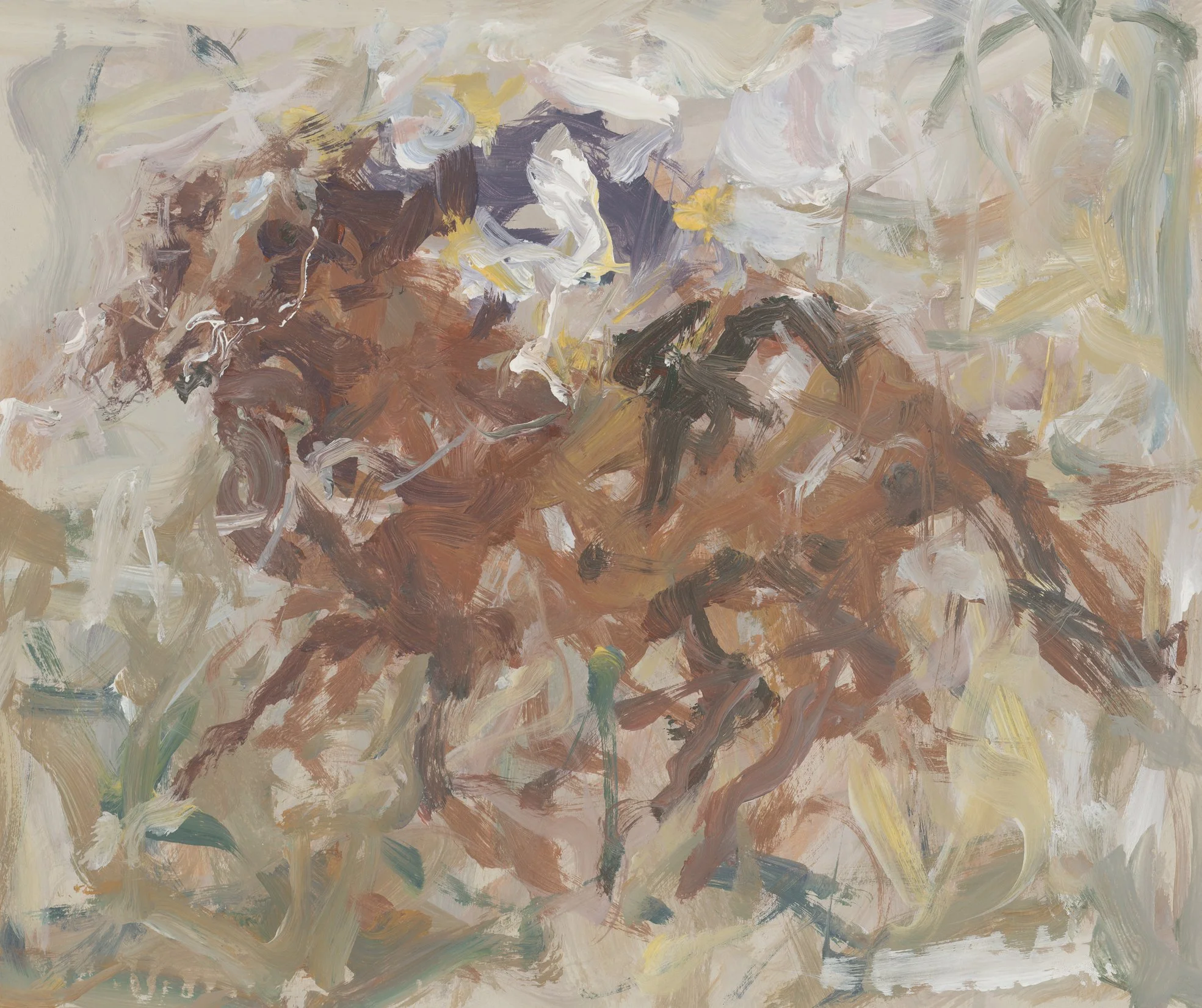
Horse Shadow 04
Propylene on Paper
33×28 cm
2023
-
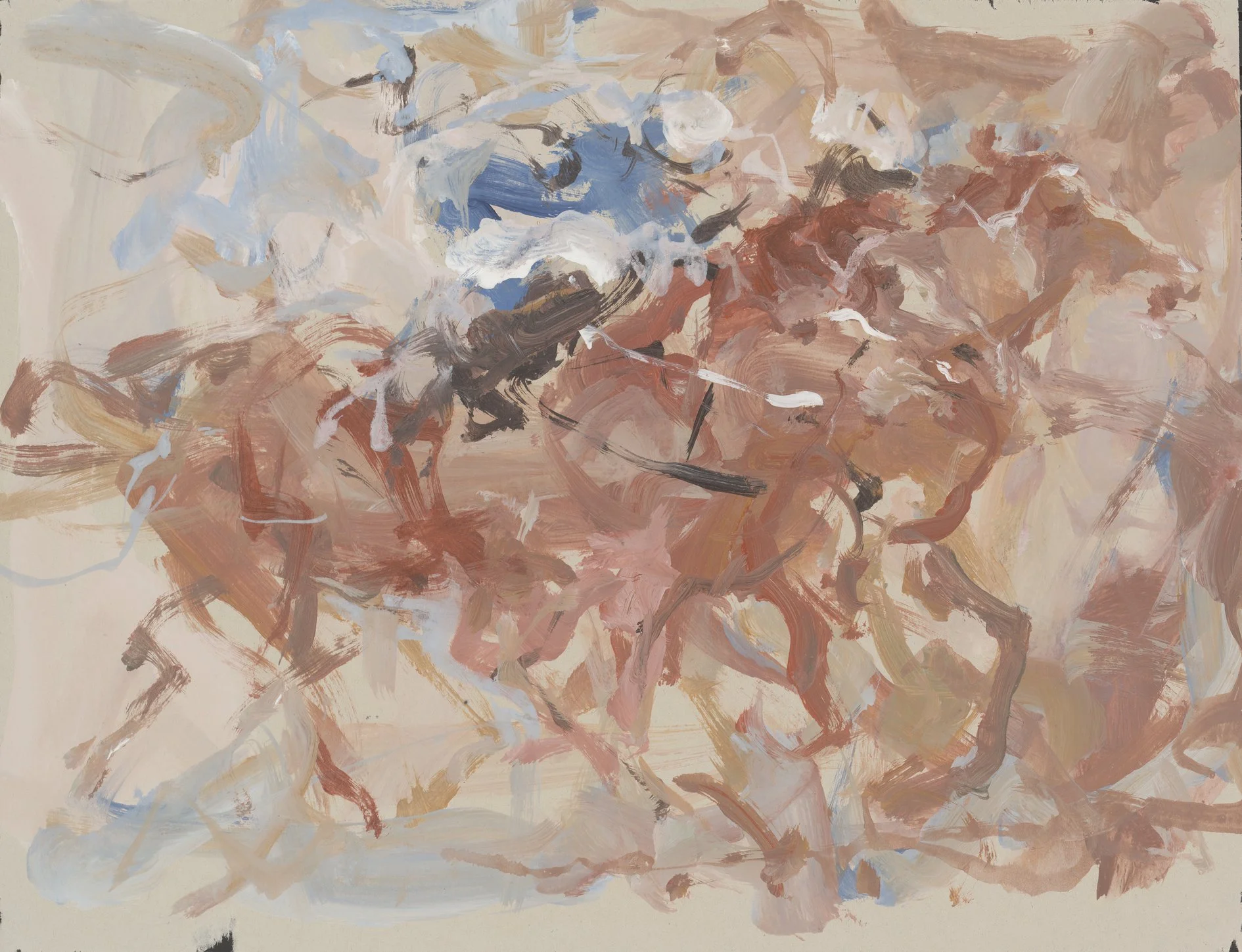
Horse Shadow 05
Propylene on Paper
32×24 cm
2023
-

Horse Shadow 06
Propylene on Paper
31×23 cm
2023
-

Horse Shadow 07
Propylene on Paper
32×26 cm
2023
-

Horse Shadow 08
Propylene on Paper
29×33 cm
2023
-

Horse Shadow 09
Propylene on Paper
32×34 cm
2023
-
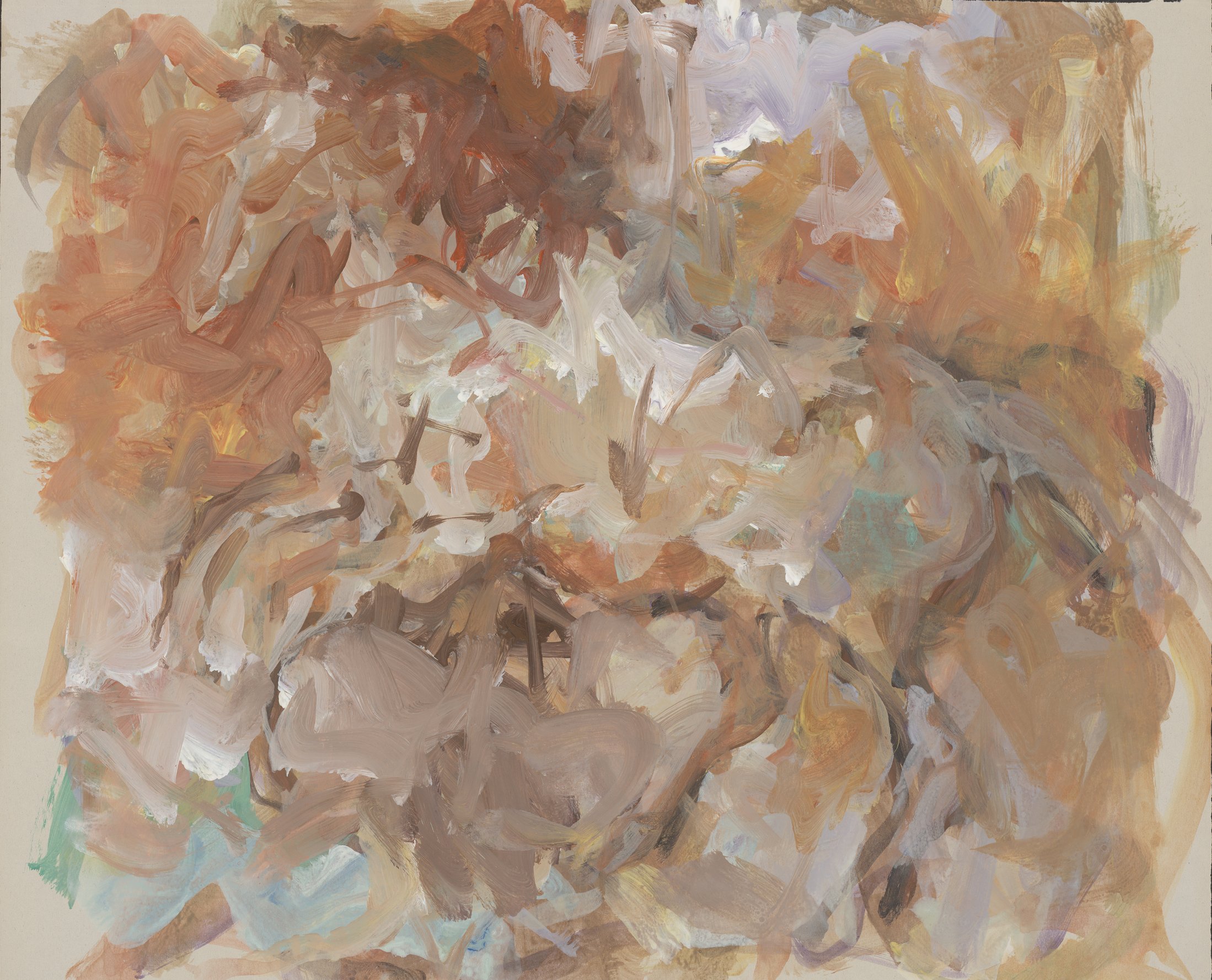
Horse Shadow 10
Propylene on Paper
37×30 cm
2023
-
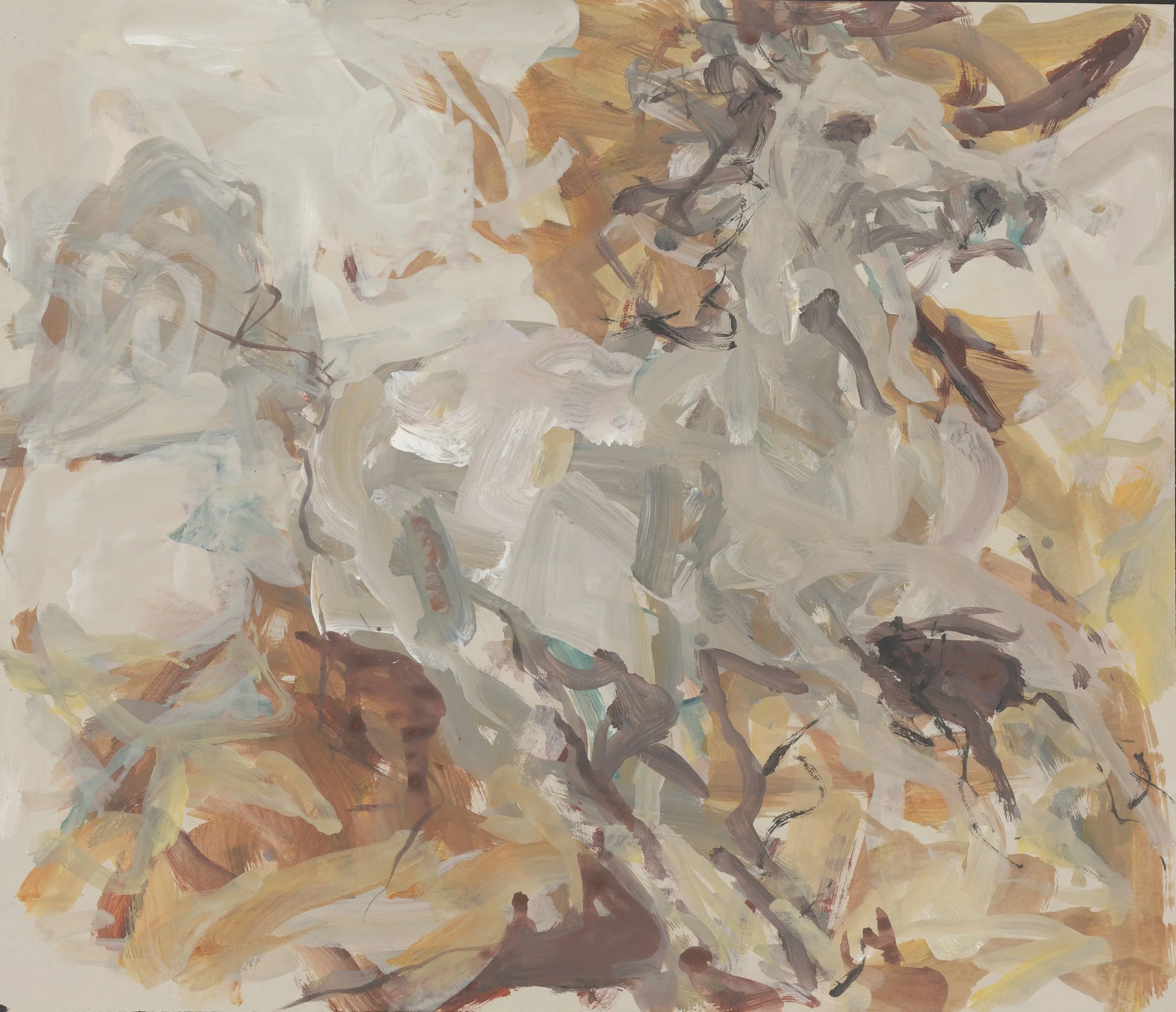
Horse Shadow 11
Propylene on Paper
28×34 cm
2023
-

Horse Shadow 12
Propylene on Paper
28×34 cm
2023

Artwork Interpretation
Still jollification
This is a triptych that captures the lively atmosphere of a racetrack through a relatively still moment.
The standing horses and the silhouettes of their riders are the main contents of the image. On the right side of the canvas, three groups of racehorses create a relatively symmetrical arrangement in the midground, while the left edge outlines a rider stepping out of the picture, drawing viewers’ attention to the foreground. The light sky at the top effectively balances the heavy brushstrokes at the bottom, creating an echo between the foreground and background while adding a sense of rhythm to the bustling scene.
In the later part of his career, Edgar Degas painted several similar works as this image, such as Race Horses at Longchamp and Jockeys. His depictions of standing or trotting racehorses, especially from the rear perspective, aim to capture the rare moments of tranquility at the racetrack. In Degas’s paintings, whether depicting pre-race warm-ups or post-race relaxation, there is an undeniable sense of serenity suspended within the canvas.
Oil on Canvas, 103*163 cm, 2023
Interestingly, however, BEI Jiaxiang manages to evoke the vibrant energy of the racetrack within such similar composition. First and foremost is the role of vivid colors. BEI employs highly saturated, bright hues, exaggerating reality to maximize the hormonal excitement of the athletic event. Next, he brings the overall perspective closer, leaving only a small glimpse of sky while nearly omitting the grass; the clearly defined groups of racehorses fill the canvas, creating an immediate sense of vitality. Lastly, with the overlapping vertical strokes, countless hoofprints are laid at the bottom, while a sea of spectators gathers in the distance, greatly enriching the emotional depth and tension of the painting.
In BEI’s words, the creative process is one of continuous “tossing away,” and in this work, he “tossed away” many of Degas’s shadows, in order to gradually stand upon his own racetrack.
The Knights…
In BEI Jiaxiang’s Knights Series, the aesthetic of colour sets up a visual battle across cultural boundaries. Amidst the cold mist interwoven with cobalt blue and ultramarine, horses in ochre tear through the spatial expanse with an almost provocative stance. This extreme confrontation between complementary colours and the warm-cool tonalities serves as both a snapshot of the galloping moment and a flowing timeline within an ink wash scroll.
As a cultural wanderer, BEI’s creation always navigates along the dialectics of deconstruction and reconstruction, and the muscular lines of the horses he depicts reveal a unique aesthetic inclination. The precise analysis of horses’ skeletal structure stems from long-term observation at the Melbourne racetrack, while the exaggerated neck curves and body lines clearly inherit the classic forms of Han Dynasty brick paintings. The dynamic portrayal of the leaping horses reflects not only the brushwork and aesthetic interest found in traditional Chinese expressive ink paintings but also resonates with Théodore Géricault’s romantic capture of movement. This hybridisation of dual genes crossing two cultural systems reaches its peak in the Knights series.
In contrast to the characterisation of the horses, the riders on their backs remain indistinct. BEI uses silver-grey strokes dragged horizontally with a palette knife to suggest the contours of the riders, whose forms are often simplified into fluid linear structures that blend seamlessly with the horse’s tail. The contrast between the tangible presence of the horses and the ethereal shadow of the riders is intentionally emphasised, achieving a spiritual pursuit of man and horse as one.
These horses, wandering between the concrete and the abstract, the East and the West, tradition and contemporary styles, are not only metaphors for BEI Jiaxiang’s personal creative journey but also indicate a paradigm shift in contemporary art production within a cross-cultural context—reborn in deconstruction, fused in confrontation, and reaching new aesthetic realms in the fervour of gallop.
Prancing
BEI’s use of lines initially recalls Pollock’s drip painting, Untitled. Both artists exhibit absolute control over lines, masterfully maintaining a balance between presence and absence in traditional notions of “form.” However, unlike Pollock, BEI does not rely on the randomness of external tools; instead, his personal intent subtly permeates each stroke, exemplifying a seamless, almost invisible art of creation.
BEI Jiaxiang’s confident and unrestrained approach to line is fully unleashed in the Journey series.
At first glance, the bold lines create a striking vibration that transcends color, evoking both physical and emotional intensity. The lines infuse the canvas with dramatic impact, drawing the viewer into an indescribable tension and fervor even before rational understanding of the content begins.
Upon closer inspection, the intricate interplay of lines forms powerful racehorses and elegant riders. Serving to both define and blur traditional boundaries, BEI’s lines sometimes render the horse’s form elusive, while at other moments, it vividly emerges. The diagonal and curved strokes fluidly capture the horses’ dynamic movements, suggesting a vital speed and strength. Sharp, unconventional short strokes highlight the sense of motion, intensifying the tension and vitality of the composition.
Typically, colours serve as primary conveyors of emotion, yet here they assume a supportive role. This does not imply that BEI neglects the significance of colour; rather, the palette predominantly consists of soothing warm tones, which are not typically associated with passion. His intention is to achieve motion through stillness—these gentle hues not only accentuate the power of the lines but also temper the restlessness and unease that the lines might convey.
Chase the Wind…
BEI Jiaxiang’s Chasing Wind series, with its dual interpretation of speed and memory, becomes another significant work in the artist’s integration of Eastern imagery and Western expressive aesthetics. In contrast to the conventional passion of galloping horses, this series places greater emphasis on capturing the philosophical interplay of the real and the ephemeral within dynamics.
The Chasing Wind series breaks through the linear narrative of traditional racing themes, adopting a radiating composition to enhance visual momentum. The herd of horses expands outward from the canvas, creating a centrifugal tension; meanwhile, the large areas of blank space in the corners align with the Chinese landscape painting principle of “reckon blank as inked”.
BEI’s brushwork combines the expressive nature of Eastern calligraphy with the wildness of Western expressionism. He outlines the muscular forms of the horses with thick, rugged applications while employing dry brush strokes to convey the ethereal quality of their manes, producing effects reminiscent of Chinese ink wash. This technique echoes the abstract treatment of animal forms by German expressionist painter Franz Marc while incorporating the concept of “expressing spirit through form” from Chinese literati painting. The horses, blurred into semi-abstract shapes, evoke both the contemporary embodiment of the “Vigor Spirit” in Chinese culture and the deconstructed reimagining of freedom in the epic of Australian pioneering history. BEI intentionally dissolves the physical presence of the riders, allowing the horses to become pure spiritual vessels.
Thus, the Chasing Wind series represents not only BEI’s bold breakthrough in the boundaries of oil painting language but also his aesthetic declaration of cultural identity. By infusing the “imagery” thinking of Chinese literati painting into the dynamic expressive framework of the West, the artist captures the continuity of time within the solidified moments of oil paint. In the rush of the brush strokes, a poetic reconciliation between the East and the West, tradition and modernity is achieved.
Swanking Race
In BEI Jiaxiang’s new horse series Journey, this work stands out for its exceptional mastery of colour.
The overall image is boldly painted in warm tones primarily of pumpkin orange and scarlet, creating an immediate visual impact and a passionate undertone in the content. The few patches of indigo not only provide a good balance in visual contrast but, more importantly, introduce elements of calmness and tension, enhancing the sense of chaos in the galloping horses, adding depth and intensity.
BEI uses high-contrast colored lines to doodle the facial contours of several horses, whether it’s the forehead, jawline, or just an oval representing an eye. These seemingly thin lines are instantly swallowed by the waves of colour, but soon reconnect powerfully in the viewers’ minds, making it feel as if the viewers are truly witnessing this group of racing horses charging forward.
Aside from a few individual colour blocks, most of the colours used blend together in a unique flow of brushwork, indistinguishable from one another. While they each express themselves boldly, they also create an unexpected sense of harmony. In addition to coordinating colours, BEI employs short, brisk brush strokes to convey instantaneous movement, almost allowing one to feel the vibrations of hooves striking the ground. Besides, he uses fluid long strokes to express overall flow, perfecting the rhythm of the painting.
As a pioneering artist who transcends representational depiction through colour expression, BEI’s work may echo Kandinsky’s series Composition. The necessity of narrative in the image is continually weakened, yet the desire for expression surges forth more than ever. The artist is responsible for constructing the emotional surface of the painting while leaving enough space for the viewers to delve into the deeper intricacies of the work.
Galloping as Wind
The character Xiang in BEI Jiaxiang’s name originally signifies horses “raising head while galloping,” serving as a fitting metaphor for his artistic destiny. Having resided in Australia for over two decades, with Melbourne’s racecourse near his studio, this geographical affinity further ignited his obsession with the speed, resistance, and vitality inherent in horse racing. The horse-themed works that emerged from this influence have become the central motif throughout BEI’s artistic career, galloping across mediums between oil and ink, crafting a cross-cultural visual poetry.
In his series of oil paintings, BEI abandons the rigid conventions of academic realism, employing bold, expressive brushwork and contrasting colours to transform speed into palpable visual energy. Within the rough scraper marks and flowing layers of paint, he unleashes raw, primal vitality. This dynamic capture diverges from Degas’s elegant freeze-frame of horse racing moments, instead channeling the fervor of Expressionism—turning the racecourse into a battleground of force and beauty.
If oil painting signifies an eruption of power, ink wash becomes a condensation of spirit. BEI reciprocates the textured depth of oil with the subtleties of ink, deconstructing form through abstract brushwork that marries Western Abstract Expressionism with the “unfinished” aesthetic rooted in Chinese literati painting. Furthermore, he infuses the flowing curves from Matisse’s Dance into ink, transforming bodily forms into shimmering illusions of light and color amidst the mist of raw xuan paper, achieving a historical reconciliation of the traditional literati’s aloofness with Monet’s haziness within the dimension of ink.
BEI Jiaxiang’s horses are more than mere subjects; they embody technological innovation, philosophical practice, and cross-cultural spirits. Leaping from the dust of the racecourse into the void of ink and the fluidity of oil, they freeze in eternal motion at the confluence of Eastern and Western art—embodying force and beauty in perpetual motion. This is the BEI’s ode to life’s passion, as well as a modern pathway of writing Oriental charm in the Western way.
Dashing in the Breeze
BEI Jiaxiang’s Dashing in the Breeze uses a square canvas as its stage, weaving together vibrant orange and magenta as dominant hues with cold-toned lines of lake blue, black green, and indigo to construct a visual tension.
At the centre of the composition, the racehorses and riders are thoroughly deconstructed into curved colour blocks; the boundaries between limbs and background dissolve within the momentum of speed, as if the galloping horse’s trajectory is sketching ripples of energy through the air. The trembling directions of the colour blocks hint at the path of speed, while the cold-colored lines slice across the canvas like blades—evoking the fluidity of ink wash’s “dripping marks” yet aligning with Western Expressionism’s capture of motion.
Although BEI has lived in Australia for years, his creation remains deeply rooted in the inclusive genes of Shanghai Art School. The use of highly saturated colours in the painting shines with Fauvist spirit; the collision of orange blocks releases primal vitality, while the trembling brushstrokes at the edges and the incidental ink wash diffusion further enhance the decorative qualities of the work. The pale hues at the top of the canvas break the density by means of negative space, injecting a sense of breath between the warm tones and the restraint of the cooler ones—forming the dialectical rhythm of “the interplay of emptiness and fullness” in Eastern aesthetics.
The unique value of Dashing in the Breeze lies in its conscious dual cultural identity. Technically, BEI Jiaxiang fuses Chinese and Western brush expressions into a personalised language of “colour-block calligraphy”; conceptually, he grafts the literati painting’s spirit of freehand brushwork onto Western abstraction, elevating the traditional subject of the horse into a cross-cultural aesthetic spiritual carrier. The confrontation of color and the interplay of emptiness and fullness in the composition is not only a visual celebration but also a metaphor for the eternal struggle between passion and reason—much like Shanghai Art School’s self-positioning amid globalization: embracing formal innovation of modernity while steadfastly guarding the spiritual roots of local aesthetics.
Riding freely in unreality
Even in the masterful application of line in the Journey series, the expression of colour and light cannot be overlooked.
BEI Jiaxiang boldly employs bright hues such as grass green, egg yellow, and misty blue, capturing the impact of galloping racehorses. He even mixed substantial amounts of white into already light pigments, creating a sense of weightlessness. Coupled with the horses’ upwardly lifted hooves, it feels as if, amidst a whirlwind of dust, these steeds have crossed the boundary between reality and dreams. Not only are the horses in motion, but the entire background teeters on the edge of dynamic tension.
On the traditionally brown-red depicted bodies of the horses, BEI initiates his experimental approach to colour. Unmixed ochre defines the muscular legs, while the addition of carbon black transforms them into flowing manes and tails. Most strikingly, the bright yellow hue of the central horse radiates a vibrant luminosity. BEI accentuates the elegant lines of the horse’s face with subtle highlights in a pale yellow-green, which simultaneously deepens the darker tones of the eyes. A touch of egg yellow on the chest may represent a natural light or the reflection from the yellow-clad rider behind, expertly revealing the rich texture of the horses in motion with just a few well-placed strokes.
Traditional equine painter Alfred James Munnings also placed significant emphasis on the use of colour. He employed naturalistic colours and meticulously treated light and shadow to faithfully reproduce the realism and three-dimensionality of horses’ hair. However, a review of his artistic evolution reveals that his later works increasingly absorbed an understated Impressionistic style. As Munnings began to introduce colours absent from nature, the horses in his paintings came to life in a more vivid manner. This aligns beautifully with BEI’s artistic exploration.
Journey 2025
In his 2025 horse oil painting series, BEI Jiaxiang embarks on a profound and richly nuanced new chapter in his ongoing exploration of abstracted galloping horses. While continuing to distil the dynamic essence and spirit of these majestic creatures, he revisits and reinterprets the language of colour with renewed innovation and harmony.
Deliberately tempering the bold, vibrant hues that characterised his earlier works, BEI now turns with deep affection to the more subdued, introspective palette of classical tradition. Earthy ochres, warm umbers, muted grey-blues, and meticulously layered shades of black, white, and grey reclaim dominance on the canvas. These colours—steeped in historical resonance and timeless beauty—lend the compositions a solemn yet profound gravitas.
Yet this is no mere exercise in nostalgia. BEI boldly and masterfully fuses the time-honoured richness of classical tones with his signature contemporary abstraction—a language of unrestrained, expressive brushwork. The warmth and depth of classical hues infuse his dynamic forms with quiet strength and historical weight, while his modern, gestural strokes breathe unprecedented vitality and rhythmic movement into the dignified palette. Here, the force of new techniques and the resonance of old harmonies coexist in perfect balance, forging a singular visual experience—one that pulses with the raw energy and formal freedom of Abstract Expressionism, yet remains anchored in the eternal spirit and inner warmth of classical painting.
Through BEI Jiaxiang’s relentless experimentation and expansive artistic vision, classical aesthetics find fresh articulation in the contemporary realm. Tradition is not merely preserved but revitalised, proving its enduring relevance in an ever-evolving artistic landscape.





